





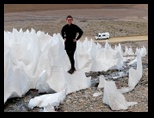
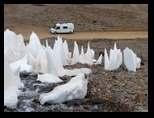
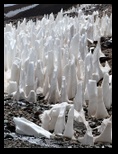
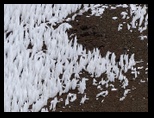

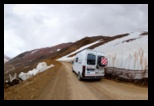


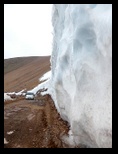

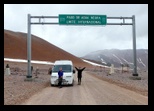
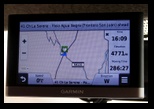
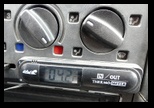

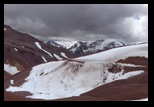
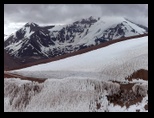
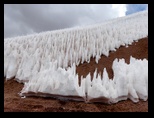
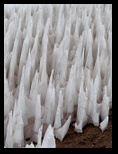
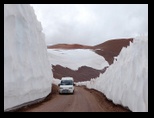


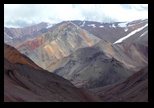


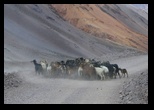


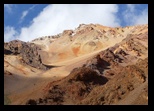

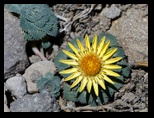
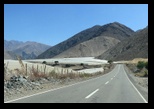


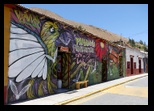
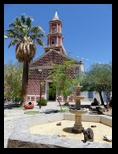
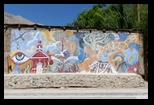
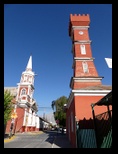
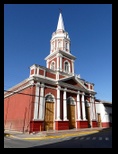
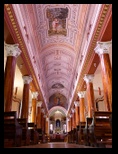
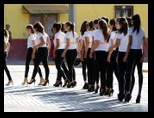
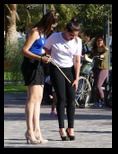
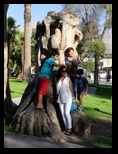

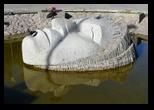
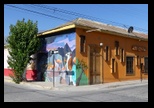
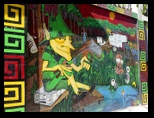
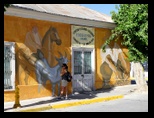


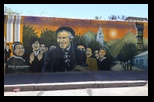
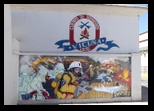
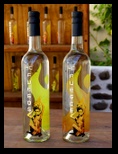
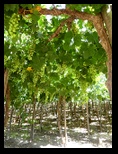


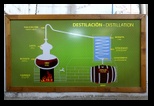
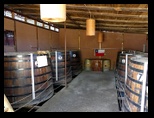
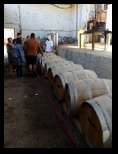
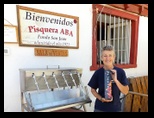


Click on a photo to enlarge it.
Merry Christmas! We stayed at a quiet petrol station for the night and fetched some croissants from the shop for breakfast. I also used the internet to phone my family in England to wish them a merry Christmas.
We drove to the customs office and it only took 10 minutes to get through the border crossing formalities on the Argentinian side. The actual border is 90km away and it is a further 90km to get to the Chilean border post. In between is the Paso del Agua Negra at 4765m, the highest border crossings between Argentina and Chile. The customs office is at 1890m so we had quite a few metres height to gain.
The first part of the road was under construction and a lot of gravel along a flat plateau heading towards the mountains. There was also a stretch of tarmac in between where there was a checkpoint and we had to hand in a piece of paper from the customs office.
Shortly afterwards we hit the first switchbacks but pulled off for a lunch stop as we didn't know whether there would be any suitable places to pull over further up. At least there wasn't much traffic on the road - well it is Christmas day!
35km before the pass we hit gravel road again and there wouldn't be any more tarmac until we got to the Chilean customs office, 125km further on. It took us over 3 hours to get up to the pass even though it was only 35km. That's because we had a lot of photo stops. We also passed an area with a sign informing us of a tunnel project between Chile and Argentina which will greatly shorten the distance and will probably be all tarmac. At least we got to see the spectacular scenery of this area before the new road and tunnel are built.
The new tunnel will cut out the best part of the road - going past the "Penitentes" - ice formations that resemble lines of monks garbed in tunics. We got out at around 4300m and climbed up a steep hill to get closer to the ice formations. Despite the altitude we both managed to get up there without any problems.
 Winnietwo going past the Penitentes - 360° Panorama
Winnietwo going past the Penitentes - 360° Panorama
(move mouse over panorama and click on the arrows)
There were several more switchbacks going past several areas of these ice formations that are formed by wind and snow melt. We got up to the pass just after 4pm and it was 4°C. We even had a few snowflakes. A white Christmas for us!!
 Switchbacks towards Paso del Agua Negra (Argentinian Side) - 360° Panorama
Switchbacks towards Paso del Agua Negra (Argentinian Side) - 360° Panorama
(move mouse over panorama and click on the arrows)
By now we were in fleece jackets and thermal leggings because the wind was bitterly cold but Winnietwo didn't have any problems getting up to the pass at 4765m. (A sign said 4653m and our GPS said 4771m, so who knows what the actual height is.) We even sang some Christmas songs! It certainly beats the 38°C weather we've been experiencing lately and we're surprised how well we're coping with both the temperature and height difference.
Unfortunately the sun was hidden by clouds which made the experience even more spectacular. We headed down the Chilean side, past more ice formations and very long switchbacks. There's a steeper short cut but we decided to take the longer route as we'll probably only be driving this pass once. Even the longer route had steep parts but first gear held us in check and saved the brakes.
We came across a herd of goats on the road and before Kirsten could get her camera out a mini tornado blew through them! We'd had quite a few along the way already and they are unbelievably strong when they hit. Fortunately the goats just turned their backs and took it in their stride. They must be used to it!
Driving Paso del Agua Negra (4765m)
Once we'd got down to 3300m the sun came out again - much to Kirstens joy as the wonderful colours of the surrounding mountains were brought out. Chile's number one export is copper and there are also nitrate mines so there's a lot of minerals and ores here that are responsible for all the different colours.
 Colourful mountains in Chile - 360° Panorama
Colourful mountains in Chile - 360° Panorama
(move mouse over panorama and click on the arrows)
Further down we found a spot to park for the night at a lagoon and dam. It was already 7pm and the border post closes at 5pm so we'd already missed it for the day. Over 7 hours of driving took a great deal of concentration so it was time to call it a day. We spent 30 minutes getting rid of dust even though we were starving - good old egg and chips were just the ticket!
It was getting a bit too cold inside so we put the heater on - nothing! It took us about 30 minutes of trying out various things and then getting the instruction booklet out - there is an AA battery needed for switching on the heater! It obviously doesn't run from the back battery. We didn't know that! So all we needed was a new battery! Fortunately we still had some from the previous owners but even then it didn't work first time because we needed to clean the contacts. Eventually we got heat and were toasty warm. Merry Christmas!
On Boxing Day the wind got even stronger and we decided to stay for the day. It was very sunny so maybe we should have waited a day to come over the pass but at least the clouds of yesterday made the drive quite dramatic. We used the day to work on our website seeing as we are still very much behind!
 Camp spot by the laguna - 360° Panorama
Camp spot by the laguna - 360° Panorama
(move mouse over panorama and click on the arrows)
We were just preparing a lentil soup for our evening meal when we got a knock on the door. It was already very late and dark outside. A man rattled off very fast Spanish and all we understood was something about us being here for two days. Incorrect of course. He was just in jeans and a shirt, no uniform and wouldn't tell us who he was or show us any ID. He wanted a photo of our license plate to give to the customs office. Not a problem because we would be going there the next day and no one had said there was a time limit for us to get to the Chilean side and fulfil all the border crossing formalities. There is a distance of 180km between the border offices and cyclists would need a number of days to get over the pass. The Argentinians had not mentioned anything and so we weren't worried.
As it happened there wasn't a problem at all when we arrived at the border office the next day despite the roadworks that are probably for the new tunnel. There was a large queue at the border but it still only took us 35 minutes to get through the passport and vehicle check. Unfortunately we lost a full pack of lentils because apparently they are not allowed (along with beans and chick peas.) We already know that fruit, veg, uncooked eggs and meat are not allowed. Also fresh cheese is not allowed so keep all the processed cheese in the original packing so they know it's from a supermarket. The customs officers even disposed of our rubbish for us! Really nice people and all very relaxed. There was no mention of a man who had handed in our license plate number!
After the border the road was all tarmac and we wound steadily down through the valley where lots of grapes are grown for wine but also for the famous Pisco, a distilled wine spirit, that is made here. The grape vines were even growing on very steep hillsides - not exactly easy to pick!
We stopped at a petrol station in Rivadavia to empty and clean the toilet and fill up with water which is our usual schedule at petrol stations. We didn't even have any rubbish to get rid of this time seeing as the very nice customs officers had done that for us already!
Whilst I was cleaning up and brushing out the carpet I noticed that one of my shoes was missing that I normally leave on the mat by the sliding door. I thought it had fallen out of the door so I looked outside and saw a black dog running around with my shoes in his mouth!!! The little bugger had nicked it. Then I had a real game trying to catch the dog and get him to give me back my shoe - he wanted to play!! Grrrrr!
After finding a small bakery for bread and a drink we set off along a road leading into Elqui Valley and parked at a viewpoint where there were picnic tables for the night. That night we got out our vehicle manual because I was having a lot of problems with reverse and first gears. We searched to find out where the gear box fluid is and how we can check it.
The next day the gears were even more of a problem. We drove onto a sandy and very narrow road that wound up the valley to get to an Artesan market in Horcón. We passed through Montegrande where Nobel prize winning poet Gabriela Mistral was born and is buried. She spent most of her life abroad.
The entrance to the market was a very steep downhill road and still sand. I was having even more problems with the gears and had worked out that to get into first or reverse I have to switch off the engine first. We parked at the top on the narrow road and Kirsten walked down to the market to check it out. There was no way we could turn on this narrow road and we knew we would have to get the problem fixed soon.
I ended up putting it into reverse, switching on the engine, reversing, switching off the engine, getting out of reverse and into first gear, switching on the engine and driving down the very steep road where we could turn. Then went through the whole process again to get turned around and we drove back up the steep hill. I kept in second, third or fourth gear and rolled towards junctions hoping to be able to keep going in second and not have to switch off to get into first gear! That's how we got back to the main road and south to Vicuña.
We stopped at a Shell garage where they had a bay and asked if one of the mechanics could take a look for us. We hadn't managed to find out where our gear box fluid dipstick is and we soon found out that there isn't one. The only way to check the gear box oil is to get underneath, and slowly turn the filling plug in the gear box. If fluid comes out that means there is enough fluid in the gear box. Our fluid came out so we knew that we had enough and that wasn't the problem with the gears.
The Shell garage is just a place for replacing fluids and doing minor work on vehicles but the mechanic suggested we might need a new connection part between the gear box and the cable. The manager told us about a mechanic in Vicuña who would be able to help us.
In the meantime our very friendly Shell mechanic cleaned our engine cover removing all the oil, gunk and sand so that it looked like new, and also used a high pressure air line to clean our air filter out and the whole thing only cost us 3,500 Chilean Pesos ($5 US). We might not have got our problem sorted out but we were a lot closer to working out the problem and we could even get into the bay and take a look for ourselves. Bit by bit we are learning about our vehicle which, no doubt, will come in very handy in the future!
It was almost 7pm and too late to go to the other mechanic so we drove into Vicuña and parked up at the main plaza. We bought a ready made chicken from the local Unimarc supermarket for our evening meal and had our favourite Chilean chocolate "Orly" for dessert - almost a real Christmas meal!
The plaza is certainly well liked by the locals and has various sculptures and even a large stage that was probably set up for Christmas. There wouldn't be anything happening that night but there were lots of people enjoying the plaza that looked and felt more like a small park in the middle of the town.
There is also a tower on one of the corners that was erected by the mayor back in 1905 - the Bauer tower. His ancestors came from Germany and the tower certainly looks German.
We got a fast internet connection so that we could order money from Western Union and pick it up from the office right on the Plaza the next day. After a peaceful night, despite being in the centre of town, we started looking up our problem on the internet. In the Ducato forum we found someone with the same problem - the clutch pedal should be higher than the brake pedal and if not we need to adjust it.
A quick look told us that our clutch pedal was a lot lower so we fetched our tools and tried to adjust the nuts on the cable. There are two of them - one to be held in place whilst the other is turned to adjust the clutch. But we only have one number 17 spanner. And couldn't loosen either of the bolts. We managed to get the clutch pedal a little higher but not enough and then it slipped back into its old position.
Kirsten walked to the mechanic that was only two blocks away and was told we could go in the next day around 9am. So we spent the rest of the day working on our website and going for a short walk around the town.
It only took 10 minutes the next morning to get our clutch adjusted and the problem solved. We were charged 5,000 pesos ($7 US) which was a bit much for the amount of work but at least our problem is fixed and we have learned a great deal. We just need a second spanner and we can do it ourselves in the future.
We did a small test drive without any problems and drove to Pisqueria Aba just a few kilometres outside Vicuña. This valley is one of the most important for growing the grapes to make the famous Pisco drink and Pisqueria Aba is one of the few where they do free tours. It is a small family business that has been running since 1921. We didn't book a tour we just turned up and went on a very good tour for about an hour.
Our group included 4 French, one of whom translated the Spanish, 2 Chileans and us. The guide spoke clearly and slowly in Spanish so that we could understand. A lot of the terms were new to us but we could understand what was meant as the process for making Pisco, a national drink, is much the same as wine making. In fact they make wine first and then distil it to produce Pisco.
Peru and Chile are still arguing over who discovered it first but Pisco sour is part of the national culture made from 40% Pisco, sugar and lemon juice. The wine grapes are picked in February and March so we can only hear about the process.
Pisqueria Aba make two kinds of Pisco, one from one variety of grape and the Pisco Fuego from 5 different grape varieties. The grapes are pressed and put into large containers that hold 30,000 litres. Within 8 hours the juice is separated from the stems, seeds, and skins and transferred to other containers where it is left to ferment for 50 days without any additives.
After fermentation the juice is heated to 85°C in metal containers and distilled. This process causes gases such as ethanol and methane amongst others which are then cooled. The alcohol content is measured and the ethanol is removed to large wooden barrels and left for 2 years. The other gases are removed and shipped to other factories for further use or disposal - some are poisonous!
After two years the distilled wine has a 72% alcohol content which is mixed with pure water until the alcohol is 40% and then filled into bottles. Pisco Fuego is distilled for a further year in special oak barrels from France. We were allowed to smell the bung from one of the barrels - Wow! That's strong stuff!
They produce 65,000 bottles a year and many are exported to USA, Canada and the UK. Aba has also won several awards for bottle design and packaging. After the tour we also get a tasting session. We shared the very small amounts in tiny plastic cups and it was enough to send our heads spinning!! I only tried the first one which was a mixture of Pisco and mango juice and after only one sip, I knew I had to be really careful because we hadn't had breakfast and I needed to drive!
Kirsten tried another mix of Pisco and berry juice and then came pure Pisco. Neither of us tried Pisco Fuegos as we had our eyes on a bottle that looked like Bailey's Irish Cream. It is made from Pisco, coffee and cream and they have only been producing it for one year. Well, that was more like our kind of thing. We asked if we could try it and the two French women also nodded. The men weren't that interested - it's probably more of a ladies drink!
It's not normally part of the tasting but our tour guide fetched a bottle from the fridge and opened it just for us! It really did taste like Bailey's, smooth and not so fiery. We immediately bought a bottle! It cost 7000 pesos ($10 US) so it was within our budget and the first alcohol we've bought in years - we're not really drinkers!
I drove us (carefully!) back to Vicuña via a short stop at the Shell station to tell the manager that we had been to the mechanic he'd recommended and got our problem fixed. It made him happy! We couldn't find a parking spot at the plaza so we went to a supermarket. I went shopping whilst Kirsten tried, unsuccessfully, to get internet.
Going shopping after a tasting session at a Pisco factory without having had breakfast is not the best idea. Kirsten wasn't too impressed with all of my selection - crisps, chocolate, gummi bears, custard filled profiteroles, and a German marzipan cake for her so she wouldn't complain too much! Well, at least I also got sensible stuff - tomatoes on the vine, a large yellow paprika, yoghurts, multi-grain bread etc.
It was late afternoon by the time we left Vicuña and drove 20 km towards the coast and stopped at Puclaro dam where we went for a walk on top of the dam. The parking area closed at 6pm so we had to leave but the dam personnel had told us we could drive down to the river where there are lots of camping spots to stay for the night. So we spent the night on the river with a view of the dam wall. Hope it doesn't break tonight because we are right in the waters path!